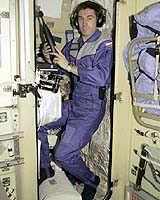
So big out there, yet so small
The ultimate off-grid home environments are ones that allow humans space living or underwater – places that may be centuries away but which still offer insight into the way we might live in the future, albeit disappointing, at least for now.
At 356ft in length, the International Space Station (ISS) is four times larger than its predecessor, Russia’s Mir space station. But the living and working quarters are still cramped and challenging for its inhabitants. Two beds like murphy beds serve three people. There are no lavatory facilities. And the sun rises every 90 minutes.
“In zero gravity body fluids accumulate in your head area, which can give you both a headache and a chipmunk-face appearance,” says astronaut Pam Melroy, a pilot on two missions to the ISS. “But, generally, your body adjusts after a few days and the sensation eases.” Weightlessness losing weight is also a problems for human muscles, bones, kidneys and other vital organs. Soyuz Space Exploration Messenger bag – buy it from Amazon
Soyuz Space Exploration Messenger bag – buy it from Amazon
In the early years of space exploration to discover, food consisted of powders, tubes and cubes. Today’s astronauts dine on real food, separate menus cater for American and Russian appetites, and the larder contains enough choice for eight days before the menu repeats the cycle. But this is not home-cooking prepared in a space-age kitchen room. Nasa’s astrogrub is thermostabilised, rehydratable . . . and irradiated.
Some of the experiments on the ISS, which is located about 200 miles above Earth, are designed to sustain life during multi-year space voyages. Replenishing the food supply is essential, so current inhabitants of the space station are working on their gardens. The Biomass Production System (BPS) centres around a high-tech growing box in which wheat and other plants are grown in chambers where all the variables upon which plants depend (light, temperature, moisture, nutrients, and atmosphere) are controlled. Early human visitors en route to, perhaps even on, Mars may be eating fresh fruit and vegetables courtesy of these trials, as well as breathing the oxygen plants produce. With more ambitious meals in mind, Nasa has called one food project Photosynthesis Experiments and System Testing and Operations; it’s acronym is Pesto.
Underwater living is another area for Nasa exploration, primarily through its Nasa Extreme Environment Mission Operations (acronym: Neemo, evoking Nemo, the captain of the submarine Nautilus in Jules Verne’s 20,000 Leagues Under the Sea).
Offering five-star luxury compared with the ISS, Neemo has proper beds and toilets, a shower, and kitchen facilities that include a microwave, instant hot water, refrigerator, sink and dining area – all 62ft beneath the sea. The station relies on Aquarius, a 45ft by 13ft capsule that is the world’s only permanent underwater habitat and research laboratory. Located a few miles offshore near Key Largo, Florida, it is a short-stay home (10 to 14 days) and office for scientists trying to figure out how humans can live in unfamiliar environments, including space.
Still, it’s not home sweet home. “All of the crews report that they enjoy their stays in Aquarius, but that the isolation and cramped quarters are the most undesirable conditions,” says Kelly Humphries, a Nasa spokesman. “They liken it to sharing a tent with the same people on a long backpacking trip.”
One Response
Well this will save the souls of the VIP’s wont it!
And where do they go next?
What mountain to climb? what city to invade and conquer?